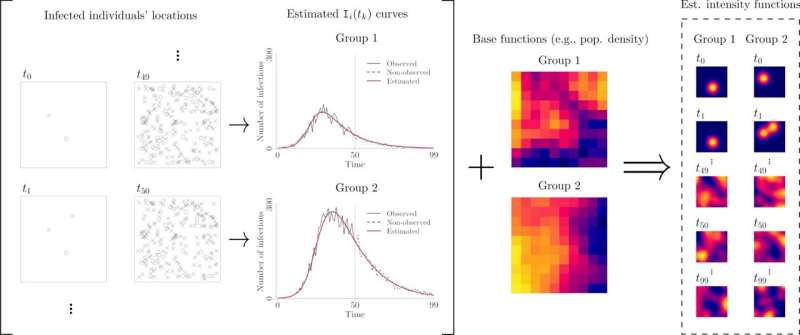This article has been reviewed according to Science X's editorial process and policies. Editors have highlighted the following attributes while ensuring the content's credibility:
fact-checked
peer-reviewed publication
trusted source
proofread
Better disease model accounts for contact patterns between age groups

A new disease model that can account for contact patterns between age groups shows how infectious diseases evolve in space and time and how to predict future case numbers across a region.
The COVID-19 pandemic has highlighted the importance of modeling to help understand disease spread and to provide valuable insights into disease prevention and control. A new model has used COVID-19 data and integrated two classic approaches to improve predictions about disease spread.
A common modeling approach is to split the population into compartments—such as susceptible (S), Infected (I) and Recovered (R), known as the SIR model—and then model the rates of change that describe how individuals move from one compartment to another.
KAUST researchers, led by Paula Moraga, integrated SIR compartment modeling in time and a point process modeling approach in space–time, while also taking into account age-specific contact patterns. To do this, they used a two-step framework that allowed them to model data on infectious locations over time for different age groups.
"The model gives more accurate predictions than previous approaches when making short/mid-range predictions in space and time," says lead researcher André Amaral.
"It also accounts for different age classes so we can treat these groups separately, resulting in finer control over the number of infectious cases."
Their approach paid off. In a simulation study to assess the model's performance, and in a case study of COVID-19 cases in Cali, Colombia, the model performed better when making predictions and provided similar results for past time points, compared with models commonly used in predictive modeling.
"The model's features can help decision-makers to identify high-risk locations and vulnerable populations to develop better strategies for disease control," says Amaral.
It also can be used with any infectious disease that fits the compartment model assumptions, such as influenza. Furthermore, the model can account for different age groups and their associated contact patterns, meaning it allows more detailed conclusions about where, when and to which population group decision-makers should focus their resources if they want to control disease spread.
"In future work, we might extend such an approach and use different temporal models to replace the SIR model. This would allow us to account for different epidemic dynamics and expand the number of scenarios that the model can be used for," says Amaral.
"Finally, to improve the model's predictive capabilities, we might work on developing ensemble approaches that combine a number of predictions from a number of different models and also account for potential time delays in collecting data," he adds.
Moraga says the model's performance demonstrates the importance of quality and detailed data by location, time and population group to understand infectious disease dynamics, while highlighting the need to strengthen national surveillance systems to improve public health decision-making.
The paper is published in the journal Stochastic Environmental Research and Risk Assessment.
More information: André Victor Ribeiro Amaral et al, Spatio-temporal modeling of infectious diseases by integrating compartment and point process models, Stochastic Environmental Research and Risk Assessment (2022). DOI: 10.1007/s00477-022-02354-4





















